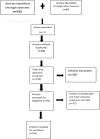Scoping review of acute stroke care management and rehabilitation in low and middle-income countries
- PMID: 31684935
- PMCID: PMC6829977
- DOI: 10.1186/s12913-019-4654-4
Scoping review of acute stroke care management and rehabilitation in low and middle-income countries
Abstract
Background: Stroke is a major public health concern, affecting millions of people worldwide. Care of the condition however, remain inconsistent in developing countries. The purpose of this scoping review was to document evidence of stroke care and service delivery in low and middle-income countries to better inform development of a context-fit stroke model of care.
Methods: An interpretative scoping literature review based on Arksey and O'Malley's five-stage-process was executed. The following databases searched for literature published between 2010 and 2017; Cochrane Library, Credo Reference, Health Source: Nursing/Academic Edition, Science Direct, BioMed Central, Cumulative Index to Nursing and Allied Health Literature (CINNAHL), Academic Search Complete, and Google Scholar. Single combined search terms included acute stroke, stroke care, stroke rehabilitation, developing countries, low and middle-income countries.
Results: A total of 177 references were identified. Twenty of them, published between 2010 and 2017, were included in the review. Applying the Donebedian Model of quality of care, seven dimensions of stroke-care structure, six dimensions of stroke care processes, and six dimensions of stroke care outcomes were identified. Structure of stroke care included availability of a stroke unit, an accident and emergency department, a multidisciplinary team, stroke specialists, neuroimaging, medication, and health care policies. Stroke care processes that emerged were assessment and diagnosis, referrals, intravenous thrombolysis, rehabilitation, and primary and secondary prevention strategies. Stroke-care outcomes included quality of stroke-care practice, functional independence level, length of stay, mortality, living at home, and institutionalization.
Conclusions: There is lack of uniformity in the way stroke care is advanced in low and middle-income countries. This is reflected in the unsatisfactory stroke care structure, processes, and outcomes. There is a need for stroke care settings to adopt quality improvement strategies. Health ministry and governments need to decisively face stroke burden by setting policies that advance improved care of patients with stroke. Stroke Units and Recombinant Tissue Plasminogen Activator (rtPA) administration could be considered as both a structural and process necessity towards improvement of outcomes of patients with stroke in the LMICs.
Keywords: Acute stroke; Low and middle income-countries; Stroke care outcomes; Stroke care process; Stroke care structure.
Conflict of interest statement
The authors declare that they have no competing interests.
Figures
References
-
- Simbar M, Nahidi F, Akbarzadeh A. Quality of antenatal Care in Health Centers related to medical science University of Shahid beheshti. Ira J Payesh. 2010;11(4):529–544.
-
- McDonald KM, Sundaram V, Bravata DM, Lewis R, Lin N, Kraft SA, et al. Closing the quality gap: a critical analysis of quality improvement strategies. Vol. 7: Care Coord. - PubMed
Publication types
MeSH terms
LinkOut - more resources
Full Text Sources
Medical



